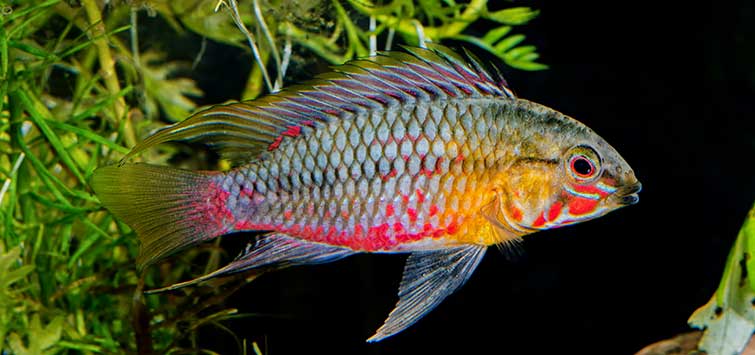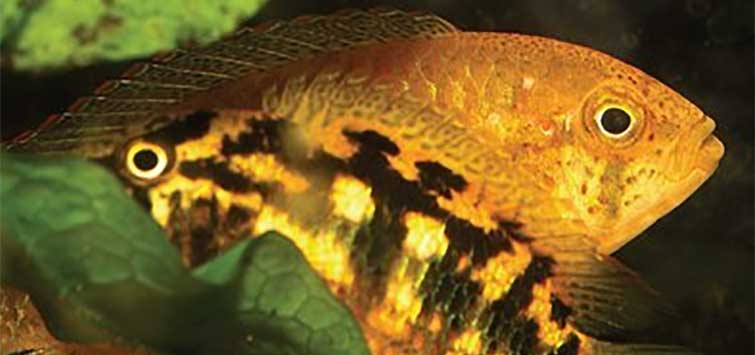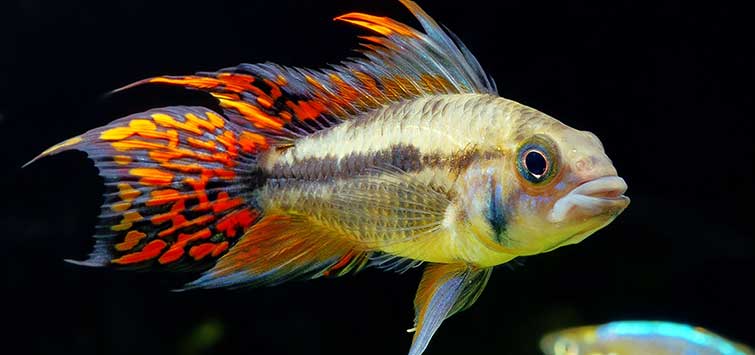Trouble-Free Dwarf Cichlids
Author: Radek Bednarczuk
Looking for a small, personable cichlid that is easy to keep? As one cichlid enthusiast explains, the three-stripe and red-line dwarf cichlids may be exactly what you're looking for.
Easy Cichlids
The majority of Apistogramma spp. are characterized by their absolute need for very soft and relatively acidic water for proper development. Achieving such parameters can be somewhat difficult for the average hobbyist, however, especially when their tap water is hard. Fortunately, there are some species of dwarf cichlids that can be kept with no problems at all in moderately hard water and at a neutral pH. Two of these are the three-stripe dwarf cichlid (Apistogramma trifasciata) and the red-line dwarf cichlid (A. hongsloi).
Unquestionably Beautiful
The species in question are very popular in hobbyists' aquariums, not only because of their special resilience, which allows them to adapt to various water parameters, but also on account of their unquestionable beauty.
The three stripes running along its body are the characteristic feature of A. trifasciata. Its specific name references this; tri (Greek) means three and fascia (Latin) means band. The dorsal fin of this species has strongly elongated anterior rays that can extend as far as the caudal fin in some male specimens.
The red-line dwarf cichlid differs somewhat from the other species. Its body is rather stout, while the body is slender and elongated in A. trifasciata. The dorsal fin of A. hongsloi is deeply serrated anteriorly, and its rays can be elongated, especially in the males. The species also has a lateral band that runs from the rear margin of the eye to the center of the upper half of the caudal peduncle, and there is a black or red spot at the base of the caudal fin. The lateral stripe is usually one scale in width and chain-like in appearance due to the fact that only the margins of the scales are colored.
Many color varieties of this species can be found in the aquarium trade. Interestingly, various color morphs can even be distinguished among siblings. Specimens hailing from Colombia are unusually colorful—they have bluish bodies with a distinct red stripe above the anal fin, while those that come from Venezuela are not as attractive in color as the other strains. Sometimes interesting color mutations of this species can appear in professional hatcheries, such as those with a distinct preponderance of red.
Natural Habitat
The red-stripe dwarf cichlid inhabits the upper and central drainage of the Orinoco River in Colombia and Venezuela. It is found in waters rich in aquatic vegetation with very gentle current. The physical and chemical parameters of their home waters are as follows: pH 5.5, very soft water, and a temperature around 26°C (79°F).
The three-stripe dwarf cichlid, on the other hand, can be found in the river systems of Brazil, Bolivia, Paraguay, and Argentina. There it inhabits small, shallow biotopes, living in clear whitewater streams. These cichlids are always found among dense vegetation, either growing on the bottom or floating on the surface where it forms a dense carpet. In its natural environment, this species likes areas with large amounts of leaf litter and shallow water near the banks. The following values were recorded in its natural biotope: pH 5.8 to 7.6, temperature 18° to 27°C (64° to 81°F), and conductivity below 150 ms/cm.
Conditions in the Aquarium
Both species can be kept in medium-hard water with a pH of 7 and a temperature of 26°C (79°F). However, soft and slightly acidic water lengthens their life span and enhances productivity. As for the aquarium substrate, it is best to use fine sand. There should be many hiding places in the form of driftwood, petrified wood, stone, plants, and leaf litter. A good choice would be Indian almond leaves.
As the mature males can show considerable aggression, the aquarium should be quite long, no less than 120 cm (50 inches) in length, and 60 to 70 cm (25 to 30 inches) wide. These fish spend most of their time at the lower levels of the tank, so its height is of little importance. Both species kept in the same aquarium provide a feast for our eyes—one is predominantly blue, the other mostly red. The aquarium should be provided with efficient biological filtration and aeration. Weekly substantial water changes, as we all know, are always necessary while keeping Apistogramma spp.
Proper sanitary conditions will protect against the fungal and bacterial infections so common in this group of fish. It is useful to know that A. trifasciata has poor resistance to various parasites and is sensitive to the drugs commonly used in the aquarium hobby. Both species' preferred foods are mosquito larvae and bloodworms, but they won't say no to quality granulated food—preferably the kind that easily falls to the bottom. We should not forget to supplement their diet with plant-based foods, such as minced spinach.
Reproduction
Sexing
Sexing A. hongsloi is very simple. The adult males reach a length of 9 cm (3½ inches). The females are a few centimeters smaller, and their coloration is characterized by a dark margin on their ventral fins, a black abdominal stripe, and sometimes an anal spot. The males, on the other hand, have fins that are significantly longer and pointed, and mature specimens have a characteristic red or black stripe along the base of the anal fin.
Maturity and Behavior
A. hongsloi matures late for a dwarf cichlid, at the age of 9 to 10 months, and it is only after 1½ years that the fish finally begin to look like adults. The good news for hobbyists is that they can live for six years when maintained in proper conditions. Optimum conditions for the red-stripe dwarf cichlid are as follows: pH of 5.5 to 6 and GH of up to 5.
The mature adult males establish their territories in the aquarium and will tolerate a number of females within them. They’ll also tolerate some young, inferior males with an undeveloped dorsal fin. But if a male with a fully developed dorsal fin enters the territory, he will be chased off immediately—sometimes it is enough for the dominant male to raise his impressive dorsal for the intruder to back off.
Courtship
Before the female lays her eggs, spectacular courtship takes place. The female chooses a rather narrow hideout that the male often cannot enter. Then she lays the eggs (possibly up to 200), and the male drives the milt inside through the opening with vigorous swipes of his caudal fin. This is how the eggs are fertilized. During spawning, the female assumes a characteristic canary yellow color. After a few days, depending on the temperature, the larvae will appear, and after a week, on average, they can be fed with freshly hatched Artemia nauplii. The young are cared for by both parents.
Three-Stripe Dwarf Cichlid Sexing
In the case of the three-stripe dwarf cichlid, only the adult specimens can be sexed. The males grow to 6 cm (2¼ inches), but the females are usually 4 cm (1½ inches). They are a yellowish color with a mixture of gray, with a small, unelongated dorsal fin with black anterior rays. The females also have a round lateral spot, with anal and dorsal fins yellow in color and rounded. On the other hand, adult males can be identified by the strongly elongated first (2 to 5) rays of their dorsal fin. Their bodies are also dark blue or azure in color. The ventral fins of the males are strongly elongated and can reach the base of the caudal fin, while the anal and dorsal fins in fully mature specimens end in long filaments.
Spawning Parameters
The fish reach sexual maturity after about half a year. The physical and chemical parameters conducive to a successful spawning are a pH of around 6 and a GH of up to 5. For the purpose of reproduction, overturned coconut shells or small ceramic pots will work well. When the female has changed color to an intense canary yellow and spends most of the day in her hideout, she has probably laid her eggs. These are usually attached to the ceiling and number around a few dozen.
Caring for the Fry
Depending on aquarium temperature, hatching will occur in three to four days, and after about a week, the young can be fed freshly hatched Artemia nauplii and microworms. The young are cared for by the female only, and it is advisable to separate her beforehand from the male and the rest of the fish, for instance, with a vertical pane of glass. However, the best method is to transfer her together with the cave and egg deposit to a separate breeding tank filled with water of the same physical and chemical parameters. The youngsters' growth rate may not be impressive, but after a month of intensive feeding, they can reach around 1 cm (less than ½ inch) in length. If you want to rear a large number of young, it is advisable to protect the eggs from fungus by treating the water with dedicated antifungal medications.
Excellent Dwarf Cichlids
Very interesting body coloration is one of the assets of these species, as is their extensive ability to adapt to varying water parameters. These fish can be maintained with no harm to their health and in full comfort in moderately hard water and at a neutral pH. It is really very convenient for us hobbyists that we do not have to prepare the water for every water change (usually with an RO filter). For this reason, the species in question are perfect for the beginning of one's adventure with the genus Apistogramma.
See the full article on TFH Digital http://www.tfhdigital.com/tfh/201301#pg77

.png?h=595&iar=0&w=2781&hash=5FD5E69473BCC22199FBFA2FB71B6033)



